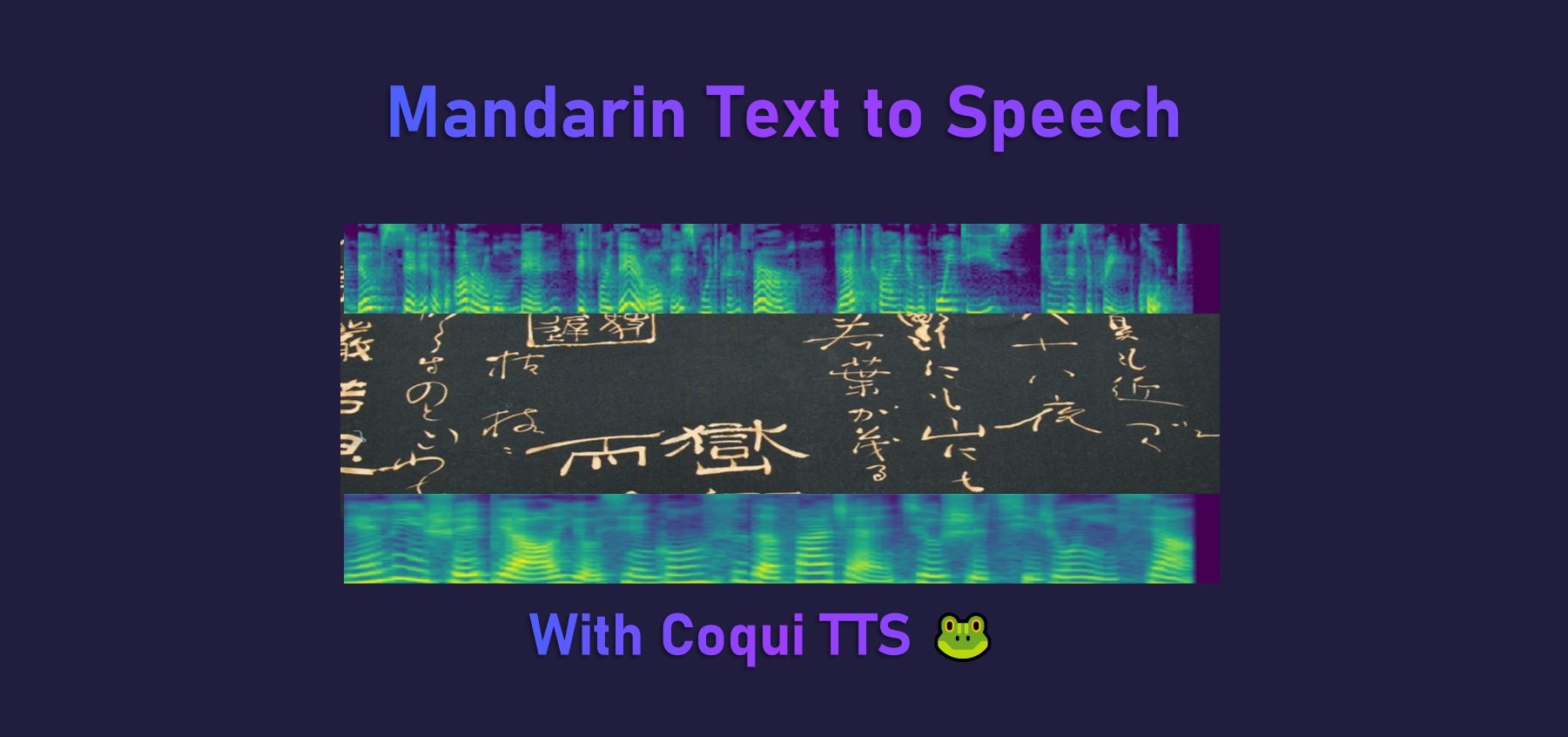tl;dr A step-by-step tutorial to generate spoken mandarin audio from text (语音合成) using the Coqui TTS library.
Practical Machine Learning - Learn Step-by-Step to Train a Model
A great way to learn is by going step-by-step through the process of training and evaluating the model.
Hit the Open in Colab button below to launch a Jupyter Notebook in the cloud with a step-by-step walkthrough.
Continue on if you prefer reading the code here.
Mandarin Text to Speech with Coqui TTS
Notebook to convert an input piece of text into an speech audio file automatically.
Text-To-Speech synthesis is the task of converting written text in natural language to speech.
The mandarin model used is one of the pre-trained Coqui TTS model. This model was from the Mozilla TTS days (of which Coqui TTS is a hard-fork). The model was trained on data from the 中文标准女声音库 with 10000 sentences from DataBaker Technology.
The notebook is structured as follows:
- Setting up the Environment
- Using the Model (Running Inference)
- Apply Speech Enhancement/Noise Reduction (Optional)
Setting up the Environment
Dependencies and Runtime
If you’re running this notebook in Google Colab, most of the dependencies are already installed and we don’t need the GPU for this particular example.
We need to install the Coqui TTS library called TTS for this example to run, so execute the command below to setup the dependencies.
!pip install -q TTS==0.4.1
Using the Model (Running Inference)
Now we want to load the specific mandarin speaker model. You can browse the full set of available models from Coqui.
Specifically we are running the following steps:
manager.download_model()- Downloads thetts_models/zh-CN/baker/tacotron2-DDC-GSTpre-trained model from Coqui. This model is a femalezh-cn(mandarin) language speaker.Synthesizer()- Setup aSythesizerfrom our model.
from TTS.utils.manage import ModelManager
from TTS.utils.synthesizer import Synthesizer
manager = ModelManager()
model_path, config_path, model_item = manager.download_model("tts_models/zh-CN/baker/tacotron2-DDC-GST")
synthesizer = Synthesizer(
model_path, config_path, None, None, None,
)
Now we define the example_text variable, a piece of mandarin text that we want to convert to a speech audio file. This particular example text asks “How are you? I’m doing fine.”.
Next, we synthesize/generate the audio file with the synthezier.tts() function.
The notebook will then display the audio sample produced for us to playback.
from IPython.display import Audio, display
example_text = '你好吗?我很好。'
wavs = synthesizer.tts(example_text)
display(Audio(wavs, rate=synthesizer.output_sample_rate))
We notice that there is actually very little noise in the generated sample. If we want to try to further enhance the quality of speech using a speech enhancement model we can move on to the next section. This is entirely optional.
Apply Speech Enhancement/Noise Reduction
We use the simple and convenient LogMMSE algorithm (Log Minimum Mean Square Error) with the logmmse library.
!pip install -q logmmse
Run the LogMMSE algorithm on the generated audio audio[0] and display the enhanced audio sample produced in an audio player.
import numpy as np
from logmmse import logmmse
enhanced = logmmse(np.array(wavs, dtype=np.float32), synthesizer.output_sample_rate, output_file=None, initial_noise=1, window_size=160, noise_threshold=0.15)
display(Audio(enhanced, rate=synthesizer.output_sample_rate))
Save the enhanced audio to file.
from scipy.io.wavfile import write
write('/content/audio.wav', sample_rate, enhanced)
We can connect to Google Drive with the following code. You can also click the Files icon on the left panel and click Mount Drive to mount your Google Drive.
The root of your Google Drive will be mounted to /content/drive/My Drive/. If you have problems mounting the drive, you can check out this tutorial.
from google.colab import drive
drive.mount('/content/drive/')
You can move the output files which are saved in the /content/ directory to the root of your Google Drive.
import shutil
shutil.move('/content/audio.wav', '/content/drive/My Drive/audio.wav')
More Such Notebooks
Visit or star the eugenesiow/practical-ml repository on Github for more such notebooks:
Alternatives to Colab
Here are some alternatives to Google Colab to train models or run Jupyter Notebooks in the cloud:
